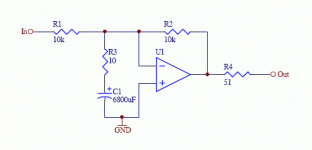Amazing work and results. I hope the author will keep up with more opamps (there are quite some [worth evaluating] devices, in particular from AD and TI).
Nothing really surprising, only the LT1115/LT1128 are dissapointing and somehow conflict with my own measurements (but then I did not evaluate the common mode linearity and the input impedance linearity).
I also hope the discrete opamp manufacturers will send samples for evaluation (to help answer the third question) but somehow I doubt they will...
Anybody asking "but how does it sound?".
Nothing really surprising, only the LT1115/LT1128 are dissapointing and somehow conflict with my own measurements (but then I did not evaluate the common mode linearity and the input impedance linearity).
I also hope the discrete opamp manufacturers will send samples for evaluation (to help answer the third question) but somehow I doubt they will...
Anybody asking "but how does it sound?".
Great Paper with very interesting commentary.
Interesting how quickly things degrade once you start to drive heavy loads and/or high output levels on most of the devices..
I might be wrong, but it looks like the AD749 comes out tops overall and the LME4xxx from Natsemi a creditable 2nd place.
The author also commented that extra care is needed on the AD device. I think th e NS device is a bit easier to use, so thats what its got in its favour.
As mentioned alreadt, congratulations are in order to Scott Wurcer!
Interesting how quickly things degrade once you start to drive heavy loads and/or high output levels on most of the devices..
I might be wrong, but it looks like the AD749 comes out tops overall and the LME4xxx from Natsemi a creditable 2nd place.
The author also commented that extra care is needed on the AD device. I think th e NS device is a bit easier to use, so thats what its got in its favour.
As mentioned alreadt, congratulations are in order to Scott Wurcer!
Bonsai said:
I might be wrong, but it looks like the AD749 comes out tops overall and the LME4xxx from Natsemi a creditable 2nd place.
There are a few very strong contenders for the first place that were not yet evaluated:
OPA211, THS4031, OPA827, OPA2822, OPA842 from TI
ADA4899-1, AD823, AD8066, AD8610, AD8599 from Analog Devices
EL2227 from Signetics/Elantec
...and probably more...
lumanauw said:Since the noise is magnified 60dB, will it interfere with the measurement, like in FFT?
Well, the noise will get worse, but according to his text, he imports the raw data into the MATLAB program and does a bunch of averaging and filtering to reduce it. I gather the noise is less of a problem than the residual distortion of the AP System 1.
syn08 said:
There are a few very strong contenders for the first place that were not yet evaluated:
OPA211, THS4031, OPA827, OPA2822, OPA842 from TI
ADA4899-1, AD823, AD8066, AD8610, AD8599 from Analog Devices
EL2227 from Signetics/Elantec
...and probably more...
...5562, CA3140. The last one has an excellent for audio output stage, but noisy input.
Wavebourn said:
...5562, CA3140. The last one has an excellent for audio output stage, but noisy input.
CA3140 - I have evaluated a few samples from Signetics and I was not happy with. The output stage might be very good, but it's a slow opamp, to slow to avoid slew rate induced distortions.
5562 - What is this?
syn08 said:
CA3140 - I have evaluated a few samples from Signetics and I was not happy with. The output stage might be very good, but it's a slow opamp, to slow to avoid slew rate induced distortions.
In applications where I use them 15V/uS is enough.
5562 - What is this?
Oops... Sorry for the typo, I mean 4562
Wavebourn said:
In applications where I use them 15V/uS is enough.
Oops... Sorry for the typo, I mean 4562
LM4562 is (AC) identical to the already tested LME49860. The slightly higher supply voltage allowed by the LME49860 is most likely the result of sorting the chips.
Unbiased, do you mean the + of the 6800uF should be more positive than the - of the 6800uF? How can we do it in a simple cct?Did anyone notice the unbiased and unbypassed 6800uF caps in the test circuits?
Attachments
- Status
- This old topic is closed. If you want to reopen this topic, contact a moderator using the "Report Post" button.
- Home
- Amplifiers
- Solid State
- Amazing opamp measurement shoot-out

